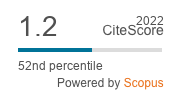Interactions in virtual social networks: a systematic literature review
DOI:
https://doi.org/10.12795/revistafuentes.2024.22046Keywords:
literature review, social networks, adolescents, interaction, socialization, communicationAbstract
Virtual social networks have been established as new social interaction spaces during the last two decades. The interaction in virtual settings as Facebook and Instagram influences adolescents´ life on different dimensions. The objective of this study is to establish the state of research about social interaction process among adolescents into the online social networks through a systematic literature review. The bibliographic search was carried out by means of PRISMA protocol and forty empirical studies, which were published between 2011-2022, were selected in the Scopus, Web of Science, SciELO and Dialnet databases. Five categories were established from the research: identity, social well-being, socio-emotional skills, risk behaviors and communication. As a result, it is evident that the adolescent population interact in virtual social networks with the purpose of obtaining social recognition, consolidating friendship ties and developing the sense of belonging to a group; however, they can be exposed to some risks such as cyberbullying. In conclusion, it is necessary to expand the research about online interactions among adolescents; as well as the need to strengthen the socio-emotional skills of adolescents into the family environment and school context for making responsible use of virtual social networks.
Downloads
References
Almenara, J. C., Pérez, S. M., Ortiz, R. V., Núñez, J. P. L., Hernández, M. L. O., & López, I. H. (2020). Students addiction to online social networks: A study in the latin american context | La adicción de los estudiantes a las redes sociales on-line: Un estudio en el contexto latinoamericano. Revista Complutense de Educacion, 31(1), 1–12. https://doi.org/10.5209/rced.61722
Bastiaensens, S., Vandebosch, H., Poels, K., van Cleemput, K., Desmet, A., & de Bourdeaudhuij, I. (2014). Cyberbullying on social network sites. An experimental study into bystanders’ behavioural intentions to help the victim or reinforce the bully. Computers in Human Behavior, 31(1), 259–271. https://doi.org/10.1016/j.chb.2013.10.036
Baumgartner, S. E., Sumter, S. R., Peter, J., & Valkenburg, P. M. (2015). Sexual self-presentation on social network sites: Who does it and how is it perceived? Computers in Human Behavior, 50, 91–100. https://doi.org/10.1016/j.chb.2015.03.061
Bernal, C., & Angulo, J. F. (2013). Interactions of young Andalusian people inside social networks. Comunicar, 20(40), 25–30. https://doi.org/10.3916/C40-2013-02-02
Beyens, I., Frison, E., & Eggermont, S. (2016). “I don’t want to miss a thing”: Adolescents’ fear of missing out and its relationship to adolescents’ social needs, Facebook use, and Facebook related stress. Computers in Human Behavior, 64, 1–8. https://doi.org/10.1016/j.chb.2016.05.083
Bohórquez López, C., & Rodríguez Cárdenas, D. E. (2015). Percepción de Amistad en Adolescentes: el Papel de las Redes Sociales. Revista Colombiana de Psicología, 23(2). https://doi.org/10.15446/rcp.v23n2.37359
Bolis, N., Ferraro, L., Nardoni, F., & Oroquieta, N. (2022). Adolescentes y espacios virtuales: Entre el sostén frágil y la alteridad en la palabra. Revista Multimedia Sobre La Infancia y Sus Institución (Es, 11(||), 58–79. http://www.infeies.com.ar
Bourgeois, A., Bower, J., & Carroll, A. (2014). Social networking and the social and emotional wellbeing of adolescents in Australia. Australian Journal of Guidance and Counselling, 24(2), 167–182. https://doi.org/10.1017/jgc.2014.14
Brown, M., Pyle, C., & Ellison, N. B. (2022). “On My Head About It”: College Aspirations, Social Media Participation, and Community Cultural Wealth. Social Media and Society, 8(2). https://doi.org/10.1177/20563051221091545
Castells, M. (2014). El impacto de internet en la sociedad: una perspectiva global. OpenMind, 1–25.
Cebollero-Salinas, A. (2021). Aprendizaje socioemocional en la comunicación online a través de la metodología de Aprendizaje-Servicio en adolescentes. Edutec. Revista Electrónica de Tecnología Educativa, 78, 196–210. https://doi.org/10.21556/edutec.2021.78.2193
Cebollero-Salinas, A., Cano-Escoriaza, J., & Orejudo, S. (2022a). Are emotional e-competencies a protective factor against habitual digital behaviors (media multitasking, cybergossip, phubbing) in Spanish students of secondary education? Computers and Education, 181. https://doi.org/10.1016/j.compedu.2022.104464
Cebollero-Salinas, A., Cano-Escoriaza, J., & Orejudo, S. (2022b). Social Networks, Emotions, and Education: Design and Validation of e-COM, a Scale of Socio-Emotional Interaction Competencies among Adolescents. Sustainability (Switzerland), 14(5). https://doi.org/10.3390/su14052566
Cebollero-Salinas, A., Cano-Escoriaza, J., & Orejudo, S. (2022c). Impact of Online Emotions and Netiquette on Phubbing from a Gender Perspective: Educational Challenges. Journal of New Approaches in Educational Research, 11(1), 64–78. https://doi.org/10.7821/NAER.2022.1.848
Correa, M., & Vitaliti, J. (2018). Estudio sobre las redes sociales personales y las redes sociales virtuales en la cibercultura adolescente actual. Summa Psicológica UST, 15, 134–144. https://doi.org/10.18774/0719-448x.2018.15.383
Courtois, C., Mechant, P., & de Marez, L. (2011). Teenage uploaders on YouTube: networked public expectancies, online feedback preference, and received on-platform feedback. Cyberpsychology, Behavior and Social Networking, 14(5), 315–322. https://doi.org/10.1089/cyber.2010.0225
del Prete, A., & Pantoja, S. R. (2020). Las redes sociales on-line: Espacios de socialización y definición de la identidad. Psicoperspectivas, 19(1), 1-11. https://doi.org/10.5027/psicoperspectivas-vol19-issue1-fulltext-1834
Ellison, N. B., Steinfield, C., & Lampe, C. (2007). The benefits of facebook “friends:” Social capital and college students’ use of online social network sites. Journal of Computer-Mediated Communication, 12(4), 1143–1168. https://doi.org/10.1111/j.1083-6101.2007.00367.x
Fernández-Montalvo, J., Peñalva, A., & Irazabal, I. (2015). Internet Use Habits and Risk Behaviours in Preadolescence. Comunicar, 22(44), 113–121. https://doi.org/10.3916/C44-2015-12
Gelpi, G. I., Pascoll, N., & Egorov, D. (2019). Sexualidad y redes sociales online: Una experiencia educativa con adolescentes de Montevideo. Revista Iberoamericana de Educación, 80(2), 61–80. https://doi.org/10.35362/rie8023230
Gentina, E., & Chen, R. (2019). Digital natives’ coping with loneliness: Facebook or face-to-face? Information and Management, 56(6). https://doi.org/10.1016/j.im.2018.12.006
Gioia, F., Griffiths, M. D., & Boursier, V. (2020). Adolescents’ body shame and social networking sites: The mediating effect of body image control in photos. Sex Roles, 1–41. https://doi.org/10.1007/s11199
Gómez Urrutia, V., & Jiménez-Figueroa, A. (2022). Identidad en la era digital: construcción de perfiles en redes sociales en adolescentes chilenos/as. Convergencia Revista de Ciencias Sociales, 29, 1-25. https://doi.org/10.29101/crcs.v29i0.17430
Gomez-Baya, D., Rubio-Gonzalez, A., & Gaspar de Matos, M. (2019). Online communication, peer relationships and school victimisation: a one-year longitudinal study during middle adolescence. International Journal of Adolescence and Youth, 24(2), 199–211. https://doi.org/10.1080/02673843.2018.1509793
Hawk, S. T., van den Eijnden, R. J. J. M., van Lissa, C. J., & ter Bogt, T. F. M. (2019). Narcissistic adolescents’ attention-seeking following social rejection: Links with social media disclosure, problematic social media use, and smartphone stress. Computers in Human Behavior, 92, 65–75. https://doi.org/10.1016/j.chb.2018.10.032
Hodkinson, P. (2017). Bedrooms and beyond: Youth, identity and privacy on social network sites. New Media and Society, 19(2), 272–288. https://doi.org/10.1177/1461444815605454
Holmes, R. M., Liden, S., & Shin, L. (2013). Adolescent Perceptions of Social Media in a Pacific Rim Community. Child Studies in Diverse Contexts, 3(2), 81–103. https://doi.org/10.5723/csdc.2013.3.2.081
Jagtiani, M. R., Kelly, Y., Fancourt, D., Shelton, N., & Scholes, S. (2019). #StateOfMind: Family Meal Frequency Moderates the Association between Time on Social Networking Sites and Well-Being among U.K. Young Adults. Cyberpsychology, Behavior, and Social Networking, 22(12), 753–760. https://doi.org/10.1089/cyber.2019.0338
Jensen, M., George, M., Russell, M., Lippold, M., & Odgers, C. (2021). Does adolescent digital technology use detract from the parent-adolescent relationship? J Res Adolesc., 469–481. https://doi.org/10.1111/jora.12618
Keresteš, G., & Štulhofer, A. (2020). Adolescents’ online social network use and life satisfaction: A latent growth curve modeling approach. Computers in Human Behavior, 104, 1-39. https://doi.org/10.1016/j.chb.2019.106187
Lee, H. Y., Jamieson, J. P., Reis, H. T., Beevers, C. G., Josephs, R. A., Mullarkey, M. C., O’Brien, J. M., & Yeager, D. S. (2020). Getting Fewer “Likes” Than Others on Social Media Elicits Emotional Distress Among Victimized Adolescents. Child Development, 91(6), 2141–2159. https://doi.org/10.1111/cdev.13422
López de Ayala López, M. C., Catalina-García, B., & Pastor Ruiz, Y. (2022). Problematic internet use: the preference for online social interaction and the motives for using the Internet as a mediating factor. Communication and Society, 35(2), 1–17. https://doi.org/10.15581/003.35.2.1-17
Luijten, C. C., van de Bongardt, D., & Nieboer, A. P. (2022). The Roles of Social Media Use and Friendship Quality in Adolescents’ Internalizing Problems and Well-being. Journal of Happiness Studies, 1-18. https://doi.org/10.1007/s10902-022-00539-w
MacIsaac, S., Kelly, J., & Gray, S. (2018). ‘She has like 4000 followers!’: the celebrification of self within school social networks. Journal of Youth Studies, 21(6), 816–835. https://doi.org/10.1080/13676261.2017.1420764
Manzi, C., Coen, S., Regalia, C., Yévenes, A. M., Giuliani, C., & Vignoles, V. L. (2018). Being in the Social: A cross-cultural and cross-generational study on identity processes related to Facebook use. Computers in Human Behavior, 80, 81–87. https://doi.org/10.1016/j.chb.2017.10.046
Marciano, L., Schulz, P. J., & Camerini, A.-L. (2022). How do depression, duration of internet use and social connection in adolescence influence each other over time? An extension of the RI-CLPM including contextual factors. Computers in Human Behavior, 136, 107390, 1-12. https://doi.org/10.1016/j.chb.2022.107390
Marín-Cortés, A., Palacio, D., Medina, J., & Carmona, A. (2021). Compasión, celos y envidia: emociones sociales y Cyberbullying entre adolescentes. Revista Colombiana de Ciencias Sociales, 12(2), 494-515. https://doi.org/10.21501/22161201.3459
Marín-López, I., Zych, I., Ortega-Ruiz, R., Hunter, S. C., & Llorent, V. J. (2020). Relations among online emotional content use, social and emotional competencies and cyberbullying. Children and Youth Services Review, 108, 1-9. https://doi.org/10.1016/j.childyouth.2019.104647
Martín-Martín, M., Asensio-Muñoz, I., & Bueno-álvarez, J. A. (2021). Use of social networks in high school students: Analysis of profiles for educational intervention | Uso de las redes sociales en estudiantes de secundaria: Análisis de perfiles para la intervención educativa. Revista Complutense de Educacion, 32(3), 303–314. https://doi.org/10.5209/rced.57189
Masanet, M. J., Gómez-Puertas, L., & Pires, F. (2021). Riesgos de la brecha digital de género entre los y las adolescentes. Profesional de La Informacion, 30(1), 1–15. https://doi.org/10.3145/epi.2021.ene.12
Page, M. J., McKenzie, J. E., Bossuyt, P. M., Boutron, I., Hoffmann, T. C., Mulrow, C. D., Shamseer, L., Tetzlaff, J. M., Akl, E. A., Brennan, S. E., Chou, R., Glanville, J., Grimshaw, J. M., Hróbjartsson, A., Lalu, M. M., Li, T., Loder, E. W., Mayo-Wilson, E., McDonald, S., … Moher, D. (2021). The PRISMA 2020 statement: An updated guideline for reporting systematic reviews. In The BMJ (Vol. 372). BMJ Publishing Group. https://doi.org/10.1136/bmj.n71
Pertegal-Vega, M. Á., Oliva-Delgado, A., & Rodríguez-Meirinhos, A. (2019). Systematic review of the current state of research on Online Social Networks: Taxonomy on experience of use. Comunicar, 27(60), 81–90. https://doi.org/10.3916/C60-2019-08
Romero Sánchez, A. (2021). Acoso escolar desde la visión de los observadores. Redes sociales y violencia física en una preparatoria de Jalisco, México. Espacios En Blanco. Revista de Educación, 1(31), 196–210. https://doi.org/10.37177/UNICEN/EB31-296
Sánchez-Romero, C., & Muñoz-Jiménez, E. M. (2021). Social and educational coexistence in Adolescents’ perception in current social problems through networks. Future Internet, 13(6),1-11.. https://doi.org/10.3390/fi13060141
Sánchez-Vera, M., Prendes-Espinosa, M., & Serrano-Sánchez, J. (2011). Modelos de interacción de los adolescentes en contextos presenciales y virtuales. Edutec-e. Revista Electrónica de Tecnología Educativa, 35, 1–14. http://sociograma.grode.org/inicio.aspx
Scoponi, P. (2019). Hacia una caracterización del ciberlenguaje adolescente: el caso de la multimodalidad en Facebook. Revista Estudios Del Discurso Digital (REDD), 2, 101–128. https://doi.org/10.24197/redd.2.2019.101-128
Singleton, A., Abeles, P., & Smith, I. C. (2016). Online social networking and psychological experiences: The perceptions of young people with mental health difficulties. Computers in Human Behavior, 61, 394–403. https://doi.org/10.1016/j.chb.2016.03.011
Szwedo, D. E., Mikami, A. Y., & Allen, J. P. (2011). Qualities of peer relations on social networking websites: Predictions from negative mother-teen interactions. Journal of Research on Adolescence, 21(3), 595–607. https://doi.org/10.1111/j.1532-7795.2010.00692.x
Ure, M. (2017). De la alteridad a la hiperalteridad: la relación con el otro en la Sociedad Red. Sophía, 1(22), 185-204. https://doi.org/10.17163/soph.n22.2017.08
Valkenburg, P. M., Koutamanis, M., & Vossen, H. G. M. (2017). The concurrent and longitudinal relationships between adolescents’ use of social network sites and their social self-esteem. Computers in Human Behavior, 76, 35–41. https://doi.org/10.1016/j.chb.2017.07.008
Van Dijck, J. (2016). La cultura de la conectividad: Una historia crítica de las redes sociales. 1–199.
Wegge, D., Vandebosch, H., & Eggermont, S. (2014). Who bullies whom online: A social network analysis of cyberbullying in a school context. Communications, 39(4), 415–433. https://doi.org/10.1515/commun-2014-0019
Published
How to Cite
Issue
Section
License
Copyright (c) 2023 SANDRA GISELA MARTÍN MARTÍNEZ, R.A. Castiblanco Carrasco

This work is licensed under a Creative Commons Attribution-NonCommercial-ShareAlike 4.0 International License.
Authors who publish in this journal accept the following conditions:
Authors conserve the copyrights and cede to the journal the right for first publication, with the work registered with the attribution licence of Creative Commons, which allows third parties to use the published work as long as they mention the authorship and the first publication in this journal.
The authors may make other independent and additional contractual agreements for the non-exclusive distribution of the version of the article published in this journal (e.g. include it an institutional repository or publish it in a book) as long as it clearly indicates that the work was first published in this journal.
Authors are allowed and indeed recommended to publish their work on the internet (for example on institutional or personal pages) before and during the revision and publication process, because it can lead to productive exchanges and greater and faster dissemination of the published work (see The Effect of Open Access).
Accepted 2023-01-11
Published 2024-01-15
- Abstract 4672
- PDF (Español (España)) 2194
- HTML (Español (España)) 207
- EPUB (Español (España)) 33















